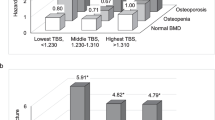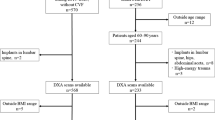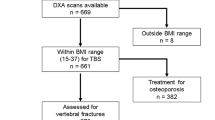Abstract
Purpose
To determine the predictive value of the vertebral trabecular bone score (TBS) alone or in addition to bone mineral density (BMD) with regard to fracture risk.
Methods
Retrospective analysis of the relative contribution of BMD [measured at the femoral neck (FN), total hip (TH), and lumbar spine (LS)] and TBS with regard to the risk of incident clinical fractures in a representative cohort of elderly post-menopausal women previously participating in the Swiss Evaluation of the Methods of Measurement of Osteoporotic Fracture Risk study.
Results
Complete datasets were available for 556 of 701 women (79 %). Mean age 76.1 years, LS BMD 0.863 g/cm2, and TBS 1.195. LS BMD and LS TBS were moderately correlated (r 2 = 0.25). After a mean of 2.7 ± 0.8 years of follow-up, the incidence of fragility fractures was 9.4 %. Age- and BMI-adjusted hazard ratios per standard deviation decrease (95 % confidence intervals) were 1.58 (1.16–2.16), 1.77 (1.31–2.39), and 1.59 (1.21–2.09) for LS, FN, and TH BMD, respectively, and 2.01 (1.54–2.63) for TBS. Whereas 58 and 60 % of fragility fractures occurred in women with BMD T score ≤−2.5 and a TBS <1.150, respectively, combining these two thresholds identified 77 % of all women with an osteoporotic fracture.
Conclusions
Lumbar spine TBS alone or in combination with BMD predicted incident clinical fracture risk in a representative population-based sample of elderly post-menopausal women.

Similar content being viewed by others
References
Johnell O, Kanis JA (2006) An estimate of the worldwide prevalence and disability associated with osteoporotic fractures. Osteoporos Int 17:1726–1733. doi:10.1007/s00198-006-0172-4
Browner WS, Pressman AR, Nevitt MC, Cummings SR (1996) Mortality following fractures in older women. The study of osteoporotic fractures. Arch Intern Med 156:1521–1525
Hannan EL, Magaziner J, Wang JJ, Eastwood EA, Silberzweig SB, Gilbert M, Morrison RS, McLaughlin MA, Orosz GM, Siu AL (2001) Mortality and locomotion 6 months after hospitalization for hip fracture: risk factors and risk-adjusted hospital outcomes. JAMA 285:2736–2742
Kanis JA, Borgstrom F, Compston J, Dreinhofer K, Nolte E, Jonsson L, Lems WF, McCloskey EV, Rizzoli R, Stenmark J (2013) SCOPE: a scorecard for osteoporosis in Europe. Arch Osteoporos 8:144. doi:10.1007/s11657-013-0144-1
Lippuner K, Golder M, Greiner R (2005) Epidemiology and direct medical costs of osteoporotic fractures in men and women in Switzerland. Osteoporos Int 16(Suppl 2):S8–S17
Lippuner K, Johansson H, Kanis JA, Rizzoli R (2009) Remaining lifetime and absolute 10-year probabilities of osteoporotic fracture in Swiss men and women. Osteoporos Int 20:1131–1140. doi:10.1007/s00198-008-0779-8
Robine JM, Paccaud F (2005) Nonagenarians and centenarians in Switzerland, 1860–2001: a demographic analysis. J Epidemiol Community Health 59:31–37
Banks E, Reeves GK, Beral V, Balkwill A, Liu B, Roddam A, Million Women Study C (2009) Hip fracture incidence in relation to age, menopausal status, and age at menopause: prospective analysis. PLoS Med 6:e1000181. doi:10.1371/journal.pmed.1000181
Ahmed LA, Schirmer H, Bjornerem A, Emaus N, Jorgensen L, Stormer J, Joakimsen RM (2009) The gender- and age-specific 10-year and lifetime absolute fracture risk in Tromso, Norway. Eur J Epidemiol 24:441–448. doi:10.1007/s10654-009-9353-8
Lippuner K, Grifone S, Schwenkglenks M, Schwab P, Popp AW, Senn C, Perrelet R (2012) Comparative trends in hospitalizations for osteoporotic fractures and other frequent diseases between 2000 and 2008. Osteoporos Int 23:829–839. doi:10.1007/s00198-011-1660-8
Lippuner K, Popp AW, Schwab P, Gitlin M, Schaufler T, Senn C, Perrelet R (2011) Fracture hospitalizations between years 2000 and 2007 in Switzerland: a trend analysis. Osteoporos Int 22:2487–2497. doi:10.1007/s00198-010-1487-8
WHO Study Group (1994) WHO Study Group on assessment of fracture risk and its application to screening for postmenopausal osteoporosis. Assessment of fracture risk and its application to screening for postmenopausal osteoporosis: report of a WHO Study Group. WHO Technical Report Series 843
Siris ES, Miller PD, Barrett-Connor E, Faulkner KG, Wehren LE, Abbott TA, Berger ML, Santora AC, Sherwood LM (2001) Identification and fracture outcomes of undiagnosed low bone mineral density in postmenopausal women: results from the National Osteoporosis Risk Assessment. JAMA 286:2815–2822 (pii:joc10548)
Kanis JA, Borgstrom F, De Laet C, Johansson H, Johnell O, Jonsson B, Oden A, Zethraeus N, Pfleger B, Khaltaev N (2005) Assessment of fracture risk. Osteoporos Int 16:581–589. doi:10.1007/s00198-004-1780-5
Link TM, Majumdar S (2004) Current diagnostic techniques in the evaluation of bone architecture. Curr Osteoporos Rep 2:47–52
Rubin CD (2005) Emerging concepts in osteoporosis and bone strength. Curr Med Res Opin 21:1049–1056. doi:10.1185/030079905X50525
Dalle Carbonare L, Giannini S (2004) Bone microarchitecture as an important determinant of bone strength. J Endocrinol Invest 27:99–105
Hans D, Barthe N, Boutroy S, Pothuaud L, Winzenrieth R, Krieg MA (2011) Correlations between trabecular bone score, measured using anteroposterior dual-energy X-ray absorptiometry acquisition, and 3-dimensional parameters of bone microarchitecture: an experimental study on human cadaver vertebrae. J Clin Densitom 14:302–312. doi:10.1016/j.jocd.2011.05.005
Pothuaud L, Barthe N, Krieg MA, Mehsen N, Carceller P, Hans D (2009) Evaluation of the potential use of trabecular bone score to complement bone mineral density in the diagnosis of osteoporosis: a preliminary spine BMD-matched, case-control study. J Clin Densitom 12:170–176. doi:10.1016/j.jocd.2008.11.006
Winzenrieth R, Michelet F, Hans D (2013) Three-dimensional (3D) microarchitecture correlations with 2D projection image gray-level variations assessed by trabecular bone score using high-resolution computed tomographic acquisitions: effects of resolution and noise. J Clin Densitom 16:287–296. doi:10.1016/j.jocd.2012.05.001
Roux JP, Wegrzyn J, Boutroy S (2012) Relationship between trabecular bone score (TBS), bone mass, and microarchitecture in human vertebrae: an ex vivo study. Osteoporos Int 23(Suppl 2):P597
Hans D, Goertzen AL, Krieg MA, Leslie WD (2011) Bone microarchitecture assessed by TBS predicts osteoporotic fractures independent of bone density: the Manitoba study. J Bone Miner Res 26:2762–2769. doi:10.1002/jbmr.499
Rabier B, Heraud A, Grand-Lenoir C, Winzenrieth R, Hans D (2009) A multicentre, retrospective case-control study assessing the role of trabecular bone score (TBS) in menopausal Caucasian women with low areal bone mineral density (BMDa): analysing the odds of vertebral fracture. Bone 46:176–181. doi:10.1016/j.bone.2009.06.032
Boutroy S, Hans D, Sornay-Rendu E, Vilayphiou N, Winzenrieth R, Chapurlat R (2013) Trabecular bone score improves fracture risk prediction in non-osteoporotic women: the OFELY study. Osteoporos Int 24:77–85. doi:10.1007/s00198-012-2188-2
Popp AW, Guler S, Lamy O, Senn C, Buffat H, Perrelet R, Hans D, Lippuner K (2013) Effects of zoledronate versus placebo on spine bone mineral density and microarchitecture assessed by the trabecular bone score in postmenopausal women with osteoporosis: a three-year study. J Bone Miner Res 28:449–454. doi:10.1002/jbmr.1775
Popp AW, Senn C, Franta O, Krieg MA, Perrelet R, Lippuner K (2009) Tibial or hip BMD predict clinical fracture risk equally well: results from a prospective study in 700 elderly Swiss women. Osteoporos Int 20:1393–1399. doi:10.1007/s00198-008-0808-7
Krieg MA, Cornuz J, Ruffieux C, Van Melle G, Buche D, Dambacher MA, Hans D, Hartl F, Hauselmann HJ, Kraenzlin M, Lippuner K, Neff M, Pancaldi P, Rizzoli R, Tanzi F, Theiler R, Tyndall A, Wimpfheimer C, Burckhardt P (2006) Prediction of hip fracture risk by quantitative ultrasound in more than 7000 Swiss women ≥70 years of age: comparison of three technologically different bone ultrasound devices in the SEMOF study. J Bone Miner Res 21:1457–1463
Official positions of the International Society for Clinical Densitometry (ISCD) (2007) Official positions of the International Society for Clinical Densitometry (ISCD). http://www.iscd.org/official-positions/official-positions/. Accessed 17 Mar 2015
Kanis JA, McCloskey EV, Johansson H, Oden A, Melton LJ 3rd, Khaltaev N (2008) A reference standard for the description of osteoporosis. Bone 42:467–475. doi:10.1016/j.bone.2007.11.001
Binkley N, Kiebzak GM, Lewiecki EM, Krueger D, Gangnon RE, Miller PD, Shepherd JA, Drezner MK (2005) Recalculation of the NHANES database SD improves T-score agreement and reduces osteoporosis prevalence. J Bone Miner Res 20:195–201. doi:10.1359/JBMR.041115
Shepstone L, Fordham R, Lenaghan E, Harvey I, Cooper C, Gittoes N, Heawood A, Peters T, O’Neill T, Torgerson D, Holland R, Howe A, Marshall T, Kanis J, McCloskey E (2012) A pragmatic randomised controlled trial of the effectiveness and cost-effectiveness of screening older women for the prevention of fractures: rationale, design and methods for the SCOOP study. Osteoporos Int 23:2507–2515. doi:10.1007/s00198-011-1876-7
Lippuner K, Johansson H, Borgstrom F, Kanis JA, Rizzoli R (2012) Cost-effective intervention thresholds against osteoporotic fractures based on FRAX(R) in Switzerland. Osteoporos Int 23:2579–2589. doi:10.1007/s00198-011-1869-6
Winzenrieth R, Dufour R, Pothuaud L, Hans D (2010) A retrospective case-control study assessing the role of trabecular bone score in postmenopausal Caucasian women with osteopenia: analyzing the odds of vertebral fracture. Calcif Tissue Int 86:104–109. doi:10.1007/s00223-009-9322-y
Del Rio LM, Winzenrieth R, Cormier C, Di Gregorio S (2013) Is bone microarchitecture status of the lumbar spine assessed by TBS related to femoral neck fracture? A Spanish case-control study. Osteoporos Int 24:991–998. doi:10.1007/s00198-012-2008-8
Breban S, Briot K, Kolta S, Paternotte S, Ghazi M, Fechtenbaum J, Roux C (2012) Identification of rheumatoid arthritis patients with vertebral fractures using bone mineral density and trabecular bone score. J Clin Densitom 15:260–266. doi:10.1016/j.jocd.2012.01.007
Krueger D, Fidler E, Libber J, Aubry-Rozier B, Hans D, Binkley N (2014) Spine trabecular bone score subsequent to bone mineral density improves fracture discrimination in women. J Clin Densitom 17:60–65. doi:10.1016/j.jocd.2013.05.001
Nassar K, Paternotte S, Kolta S, Fechtenbaum J, Roux C, Briot K (2014) Added value of trabecular bone score over bone mineral density for identification of vertebral fractures in patients with areal bone mineral density in the non-osteoporotic range. Osteoporos Int 25:243–249. doi:10.1007/s00198-013-2502-7
Briot K, Paternotte S, Kolta S, Eastell R, Reid DM, Felsenberg D, Gluer CC, Roux C (2013) Added value of trabecular bone score to bone mineral density for prediction of osteoporotic fractures in postmenopausal women: the OPUS study. Bone 57:232–236. doi:10.1016/j.bone.2013.07.040
Kolta S, Briot K, Fechtenbaum J, Paternotte S, Armbrecht G, Felsenberg D, Gluer CC, Eastell R, Roux C (2014) TBS result is not affected by lumbar spine osteoarthritis. Osteoporos Int 25:1759–1764. doi:10.1007/s00198-014-2685-6
McNamara LM (2010) Perspective on post-menopausal osteoporosis: establishing an interdisciplinary understanding of the sequence of events from the molecular level to whole bone fractures. J R Soc Interface R Soc 7:353–372. doi:10.1098/rsif.2009.0282
Senn C, Gunther B, Popp AW, Perrelet R, Hans D, Lippuner K (2014) Comparative effects of teriparatide and ibandronate on spine bone mineral density (BMD) and microarchitecture (TBS) in postmenopausal women with osteoporosis: a 2-year open-label study. Osteoporos Int 25:1945–1951. doi:10.1007/s00198-014-2703-8
Krieg MA, Aubry-Rozier B, Hans D, Leslie WD, Manitoba Bone Density P (2013) Effects of anti-resorptive agents on trabecular bone score (TBS) in older women. Osteoporos Int 24:1073–1078. doi:10.1007/s00198-012-2155-y
Kalder M, Hans D, Kyvernitakis I, Lamy O, Bauer M, Hadji P (2014) Effects of Exemestane and Tamoxifen treatment on bone texture analysis assessed by TBS in comparison with bone mineral density assessed by DXA in women with breast cancer. J Clin Densitom 17:66–71. doi:10.1016/j.jocd.2013.03.003
Acknowledgments
We are grateful to Philippe Kress, MD, for reviewing and commenting on our manuscript.
Conflict of interest
Didier Hans is co-owner of the TBS patent and has corresponding ownership shares. None of the other authors has any conflicts of interest.
Author information
Authors and Affiliations
Corresponding author
Rights and permissions
About this article
Cite this article
Popp, A.W., Meer, S., Krieg, MA. et al. Bone mineral density (BMD) and vertebral trabecular bone score (TBS) for the identification of elderly women at high risk for fracture: the SEMOF cohort study. Eur Spine J 25, 3432–3438 (2016). https://doi.org/10.1007/s00586-015-4035-6
Received:
Revised:
Accepted:
Published:
Issue Date:
DOI: https://doi.org/10.1007/s00586-015-4035-6




